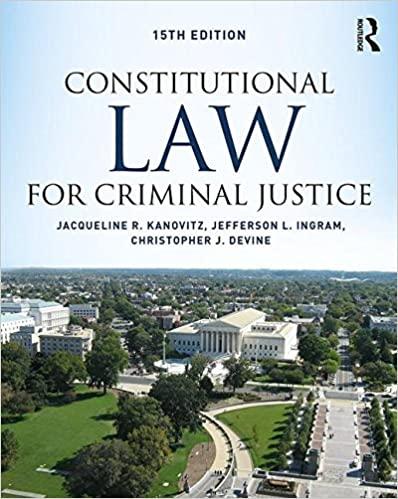Question
I need solution for business law Case 11.3 and my course code is bus 2320 cambrian college. Here is my Chapter11- Case 3 Corgi was
I need solution for business law Case 11.3 and my course code is bus 2320 cambrian college. Here is my Chapter11- Case 3
Corgi was the breeder of prize-winning pedigree dogs that often sold for very high prices. Reynolds, a wealthy businessman who had recently retired, decided to purchase one of these dogs. His intention was to enter the animal in the various dog shows that were held from time to time across the country.
Reynolds knew very little about dogs. He explained to Corgi that he wished to purchase a young dog that was already a prize-winning specimen of the breed. Corgi took Reynolds to a fenced run where several young dogs were caged. He pointed to one dog that he said, in his opinion, had the greatest potential, and that it had already won a prize at a local dog show. Corgi pointed to a red ribbon pinned to the opposite wall of the kennel building and explained that it was a first-prize ribbon that the dog had won. Reynolds did not bother to examine the ribbon.
Reynolds purchased the dog for $1,000 and took it home. Hisneighbourlater saw the dog in Reynolds' backyard. He instantly recognized it as the dog that had recently won the first-prize ribbon in the children's pet show at theneighbourhoodpark. When he told Reynolds where he had last seen the dog, Reynolds telephoned Corgi immediately and demanded his money back.
Corgi refused to return Reynolds' money or take back the dog, and Reynolds threatened to take legal proceedings against him. Reynolds was unable to do so immediately, however, as he was called out of town on a family matter the next day. He was obliged to leave the dog with hisneighbourduring his absence. Reynolds advised theneighbourto take care of the animal as if it were his own.
Reynolds was out of town for several weeks. During that time, hisneighbourentered the dog in a dog show sponsored by a kennel club. The dog won first prize in its class for its breed. On Reynolds' return, theneighbouradvised him of his success. The two men decided to enter the dog in another dog show that was scheduled to be held in a nearby city.
At this second show, the dog placed only third in its class, and Reynolds was disappointed. He returned home and immediately took legal action against Corgi.
Part 1: Case Format (See Case Study Guide)
Part 2:Discuss the basis of Reynolds' claim and thedefences(if any) of Corgiusing online resources.
How toAnalyzeLawCases
To fully understand the law with respect to business, you need to be able to read and understandcases. To make this task easier, you can usethismethod of case analysis.
You must first read the case carefully. When you feel you understand the case, you can prepare ananalysisof it. Although the format of theanalysismay vary, typically it will present the essentials of the case under headings such as those listed below.
Part 1: 4 Steps
1.Facts.
This may sound obvious, but before you can analyze or apply the relevant law to a specific set of facts, you must clearly understand those facts. In other words,you should read through the case problem carefullymore than once, if necessaryto make sure you understand the identity of the plaintiff(s) and defendant(s) in the case and the progression of events that led to the lawsuit. When you are working on case problems, realize that the facts should be accepted as they are given.In other words, avoid making conjectures; questioning the facts as they are presented only adds confusion to your analysis.
Briefly indicate
(a) the reasons for the lawsuit
b) the identity and arguments of the plaintiff(s) and defendant(s), respectively.
2.Issue.
Concisely phrase, in the form of a question, the essential issue before the court. (If more than one issue is involved, you may have twoor even morequestions here.)The basic issuemay befailure to warn customers ofawet floorwhichconstitutesnegligence. As discussed inclass, negligence is a torta civil wrong. In a tort lawsuit, the plaintiff seeks to be compensated for another's wrongful act. A defendant will be deemed negligent if he or she breached a duty of care owed to the plaintiff and the breach of that duty caused the plaintiff to suffer harm.Once you have identified the issue, the next step is to determine what rule of law applies to the issue.The nextand usually the most difficultstep in analyzing case problems is the application of the relevant rule of law to the specific facts of the case you are studying.
3.Decision.
Indicate herewith a "yes" or "no," if possiblethe court's answer to the question (or questions) in the Issue section above.
4.Reason.
Summarizeas briefly as possiblethe reasonsyou feel will begiven by the court for its decision (or decisions) and the case or statutory law relied on by the court in arriving at its decision.
Part 2: Answer the question/discussion at the end of the case.
Bus 2320 Winter 2019
Step by Step Solution
There are 3 Steps involved in it
Step: 1

Get Instant Access to Expert-Tailored Solutions
See step-by-step solutions with expert insights and AI powered tools for academic success
Step: 2

Step: 3

Ace Your Homework with AI
Get the answers you need in no time with our AI-driven, step-by-step assistance
Get Started


